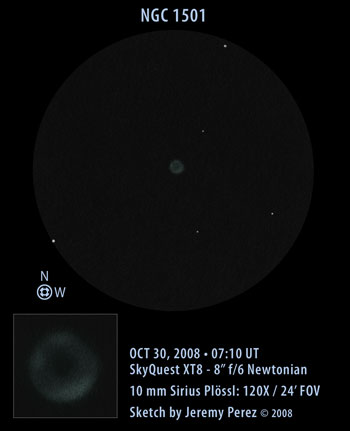Observation Notes:
This planetary nebula was a nice detour after traveling along Kemble’s Cascade and the sparkling splash of NGC 1502. It was readily evident as a soft disc at 48X. At 120X, it had a very slight aqua tint. I found it too faint to examine well at 240X, so I kept it to 120X. Averted vision revealed a thick, subtle annular shape. The southwest edge was brighter and the northeast edge seemed to have two brighter knots. The northwest side appeared somewhat flattened. I saw no evidence of a central star.
Object Information:
NGC 1501 was discovered by Friedrich Wilhelm Herschel in 1787. The planetary lies roughly 5000 light years away and is about 1.4 light years in diameter. It possesses a 14.5 magnitude Wolfe-Rayet star at its heart. It is also cataloged as: PK144+6.1, H IV-53, GC 801, PN G144.5+06.5
| Subject | NGC 1501 |
| Classification* | Planetary Nebula (3) |
| Position* | Camelopardalis [RA: 04:06:59.41 / Dec: +60:55:14.5] |
| Size* | 56″ x 48″ |
| Brightness* | 11.5 vMag (13.3 bMag) |
| Date/Time | OCT 30, 2008 – 12:10 AM MST (OCT 30, 2008 – 7:10 UT) |
| Observing Loc. | Flagstaff, Arizona, USA – Home |
| Instrument | Orion SkyQuest XT8 (203 mm dia./1200 mm F/L) |
| Eyepieces/Mag. | 10 mm Sirius Plössl (120X) |
| Conditions | Clear, calm |
| Seeing | 5/10 Pickering |
| Transparency | ~ Mag 6.5 NELM |
| *References | NGCIC.org, Deep Sky Companions: Hidden Treasures, S. J. O’Meara |

Hey Jeremy, hope all is well. Your work is so good that ine almost thinks that its a B&W image…another fabulous sketch.
regards,
Tony
Hey Jeremy, hope all is well. Your work is so good that ine almost thinks that its a B&W image…another fabulous sketch. In fact, I had it in the eye piece just about an hour ago…there is no difference between the sketch and what I saw…
regards,
Tony
Hi Tony, thanks! It’s been a while since I’ve pulled this beauty up in the telescope.
Jeremy